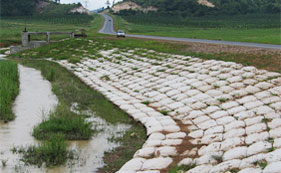
 Back to List
Back to List
1 what is a honeycomb cell
Honeycomb cell is a three-dimensional mesh cell structure formed by welding HDPE sheet material. It is generally made by ultrasonic needle welding. Due to the needs of the project, some holes are punched on the film.
2 what are the characteristics of honeycomb cell
1. The utility model has the advantages of flexible expansion, retractable and folding transportation, can be tensioned into a network during construction, and filled with loose materials such as soil, gravel and concrete to form a structure with strong lateral restriction and large stiffness.
2. Light material, wear-resistant, stable chemical properties, light and oxygen aging resistance, acid and alkali resistance, suitable for different soil conditions such as soil and desert.
3. High lateral restriction and anti-skid, anti deformation, effectively enhance the bearing capacity of subgrade and disperse load.
4. Changing the geometric dimensions such as honeycomb cell height and welding distance can meet different engineering needs.
5. Flexible and small transportation volume; Convenient connection and fast construction speed.
3 basic principle of honeycomb cell
The reason why honeycomb cell has excellent efficacy and has attracted the attention of engineering circles should also start from its basic principle. When describing its principle in foreign literature, it is called "a honeycomb three-dimensional restriction system, which can significantly improve the performance of ordinary filling materials in load-bearing and insect erosion control applications in a large range." Its key principle is three-dimensional restriction. As we all know, when the car is driving on the desert, it will press out two deep rut marks, the pressed part will sink deeply, and both sides of the rut will rise high. If the vehicle behind continues to move along the rut, the subsidence part will sink further and the uplift part will rise further until the uplift part rubs against the chassis and the subsidence rut buries more than half of the wheels, so it can't move forward. The reason for this is that when the external load acts on the foundation surface, according to Prandtl theory and Taylor theory, under the action of concentrated load, the active area 1 is pressed and sunk, and the force is decomposed to both sides and transmitted to the transition area 2, and the transition area 2 is transmitted to the passive area 3, and the passive area will deform and bulge without limitation.
Product features:
1. It can be retracted and folded freely during transportation. During construction, it can be tensioned into a network and filled with loose materials such as soil, gravel and concrete to form a structure with strong lateral restriction and large stiffness.
2. Light material, wear-resistant, stable chemical properties, light and oxygen aging resistance, acid and alkali resistance, suitable for different soil conditions such as soil and desert.
3. High lateral restriction and anti-skid, anti deformation, effectively enhance the bearing capacity of subgrade and disperse load.
4. Changing the geometric dimensions such as honeycomb cell height and welding distance can meet different engineering needs.
5. Flexible, small transportation volume, convenient connection and fast construction speed.